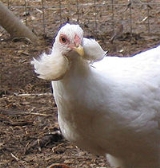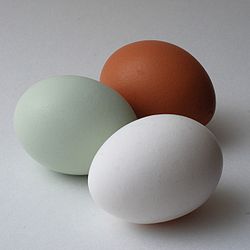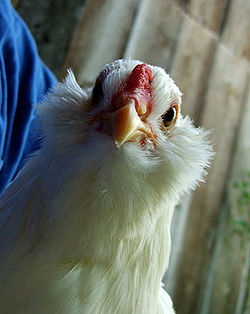
Araucana
Encyclopedia

Breed
A breed is a group of domestic animals or plants with a homogeneous appearance, behavior, and other characteristics that distinguish it from other animals or plants of the same species. Despite the centrality of the idea of "breeds" to animal husbandry, there is no scientifically accepted...
of chicken
Chicken
The chicken is a domesticated fowl, a subspecies of the Red Junglefowl. As one of the most common and widespread domestic animals, and with a population of more than 24 billion in 2003, there are more chickens in the world than any other species of bird...
originating in Chile
Chile
Chile ,officially the Republic of Chile , is a country in South America occupying a long, narrow coastal strip between the Andes mountains to the east and the Pacific Ocean to the west. It borders Peru to the north, Bolivia to the northeast, Argentina to the east, and the Drake Passage in the far...
. The Araucana is often confused with other fowl, especially the Ameraucana
Ameraucana
The Ameraucana is a breed of chicken developed in the United States. The name is a portmanteau term of American and Araucana . Ameraucanas come in both a large and bantam variety. Eight colors are officially recognized for poultry shows by the American Poultry Association: Black, Blue, Blue...
and Easter Egger
Easter Egger
An Easter Egger is any chicken that possesses the "blue egg" gene, but doesn't fully meet any breed description as defined in the American Poultry Association and/or the American Bantam Association standards. The name derives from the resemblance of their colorful eggs to Easter eggs...
chickens, but has several unusual characteristics which distinguish it. They lay blue eggs, have feather tufts near their ears, and no tail (In North America). To comply with the North American standard they must have no tail and are rumpless
Rumpless
Rumpless is a term used for the mutation which causes the tail of an animal to be absent. Usage and examples can be found in Manx cats, Manx Rumpy, Belgian d'Everberg and Araucana chickens....
.
The ancestors of the modern Araucana chicken were purportedly first bred by the Araucanian Indians
Mapuche
The Mapuche are a group of indigenous inhabitants of south-central Chile and southwestern Argentina. They constitute a wide-ranging ethnicity composed of various groups who shared a common social, religious and economic structure, as well as a common linguistic heritage. Their influence extended...
of Chile
Chile
Chile ,officially the Republic of Chile , is a country in South America occupying a long, narrow coastal strip between the Andes mountains to the east and the Pacific Ocean to the west. It borders Peru to the north, Bolivia to the northeast, Argentina to the east, and the Drake Passage in the far...
— hence the name "Araucana." The Araucana is a hybrid of two South America
South America
South America is a continent situated in the Western Hemisphere, mostly in the Southern Hemisphere, with a relatively small portion in the Northern Hemisphere. The continent is also considered a subcontinent of the Americas. It is bordered on the west by the Pacific Ocean and on the north and east...
n breeds: the Collonca (a naturally blue-egg laying, rumpless
Rumpless
Rumpless is a term used for the mutation which causes the tail of an animal to be absent. Usage and examples can be found in Manx cats, Manx Rumpy, Belgian d'Everberg and Araucana chickens....
, clean-faced chicken) and the Quetro (a pinkish-brown egg layer that is tailed and has ear-tufts). The Collonca male and female are very similar, with very few secondary sexual characteristics like comb, wattles or tail coverts to distinguish them.
The European equivalent of the North American show standard variety Araucana is what one comes across in South American villages. Quechua and Mapuche do not have tufts and resemble the Ameraucana.
The current world wide Araucana Standard (except North America) indicates a medium to large sized chicken with a tail that lays bluish-green eggs. Specific features are feather ear tufts, muffs and beards, with a very much reduced comb, a small feather crest and a complete absence of wattles.
The current North America
North America
North America is a continent wholly within the Northern Hemisphere and almost wholly within the Western Hemisphere. It is also considered a northern subcontinent of the Americas...
n standard calls for a chicken that is rumpless (missing their last vertebrae and lacking a tail), possesses ear-tufts (feathers that grow out from near the birds' ears), and lays blue eggs. In the United States and Canada, muffs, beards, and tails are all disqualifications.
The Ameraucana should also lay blue eggs, but unlike the Araucana it has a tail and possesses muffs and a beard, which are quite different from the tufts of the Araucana, and no feather crest.
The Araucana's eggs are not more nutritious than eggs of other colors, nor do they have any negative health effects.
Suggested Polynesian origin
There has long been debate whether araucanas were bred from chickens brought by Europeans to South America after Columbus or rather arose from chickens brought, perhaps by Polynesians, directly over the Pacific Ocean from someplace nearer to all chickens' presumed ancestral home in Southeast Asia. If araucanas predate the Europeans in South America, their presence implies pre-Columbian trans-Pacific contacts between Asia and South America. In 2007, an international team of scientists reported the results of analysis of chicken bones found on the Arauco Peninsula in south central Chile, and their results were published in the Proceedings of the National Academy of Sciences of the United States. This initial report suggested a Polynesian pre-Columbian origin. However, a later report looking at the same specimens concluded:
A published, apparently pre-Columbian, Chilean specimen and six pre-European Polynesian specimens also cluster with the same European/Indian subcontinental/Southeast Asian sequences, providing no support for a Polynesian introduction of chickens to South America. In contrast, sequences from two archaeological sites on Easter Island group with an uncommon haplogroup from Indonesia, Japan, and China and may represent a genetic signature of an early Polynesian dispersal. Modeling of the potential marine carbon contribution to the Chilean archaeological specimen casts further doubt on claims for pre-Columbian chickens, and definitive proof will require further analyses of ancient DNA sequences and radiocarbon and stable isotope data from archaeological excavations within both Chile and Polynesia.
Recognized breeds
The APA Araucana belong to the following Poultry Class AOSB "All Other Standard Breed " while the ABA belongs to the following class "All Other Comb Clean Leg". In Great Britain, the PCGB (Poultry Club of Great Britain) classifies it as Light, Soft Feather.The colours recognized by the APA/ABA/PCGB are :
The APA recognizes 5 colors "Black , White , Black Breasted Red , Silver Duckwing , Golden Duckwing "
The ABA recognizes 6 colors " Black , White , Black Breasted Red , Blue , Buff , Silver"
The PCGB recognizes 12 colors " Lavender
Lavender (chicken plumage)
Lavender or Self-blue refers to a plumage pattern in chickens characterized by a uniform, pale bluish grey color across all feathers. The distinctive color is caused by the action of a recessive gene, commonly designated as "lav", which reduces the expression of eumelanin and phaeomelanin so that...
, Blue, Black/Red, Silver Duckwing, Golden Duckwing, Blue/Red, Pyle, Crele, Spangled, Cuckoo, Black and White.
Araucana, Ameraucana or Easter Egger?

In the decades to follow, most breeders took one of two tactics — either to preserve the old style of bird, or to breed out the tufts while increasing productivity.
In 1976, the first standards for the breed were accepted by the APA, conforming to the traditional style. This was followed, in 1984, by a second standard for the "improved" variety.
The gene for blue eggs is dominant, so the term "Easter Egger" is used to describe birds of mixed breeding that produce such eggs. Unfortunately, these mixed breeds are often incorrectly labelled as Araucanas or Ameraucanas, and marketed to backyard poultry hobbyists who are not aware of the difference.
In short, the differences are as follows:
- USA & Canada Araucana – Tufts (lethal allele), rumpless, blue eggs, willow legs and yellow skin (with exceptions).
- US Ameraucana – Beards and muffs (NO lethal gene), with tail feathers, blue eggs, slate legs and white skin.
- British, Irish, New Zealand, Asian, Japanese, Russian, Dutch, French, Spanish, Bellarus, Ukrainian, Scandinavian, Argentinian, Chilean, South African, Pacific Islands, Brazilian, Mexican, Peruvian, Arabic Nations, Indian, Pakistan, Nepalese and Australian Araucana – Beards, muffs and crest, with tail feathers, blue eggs, slate or olive/willow legs and grey/white skin.
- Easter Egger – Variable traits.
Approximate Weight
| Cock | 6-7 lbs (2.7–3.2 kg) |
| Hen | 5-6 lbs (2.3–2.7 kg) |
| Rooster | 1.6-1.87 lbs (740g–850 g) |
| Hen | 1.5-1.75 lbs (680g–790 g) |

